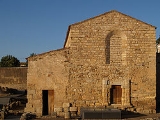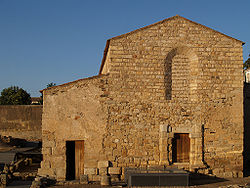
Idanha-a-Velha
Encyclopedia
Idanha-a-Velha is a parish (freguesia
) in the east of Portugal
, in the municipality
of Idanha-a-Nova
, and in the district Castelo Branco
. It covers an area of 20.98 km² and had a population of 79 as of 2001.
 As one of the oldest towns in Portugal, with a history of Roman
As one of the oldest towns in Portugal, with a history of Roman
settlement recorded since the year 16 AD, Idanha-a-Velha has been described as a "modest village with a rich historical background". Idanha-a-Velha is built on the site of the city of Egitânia, which previously had thousands of inhabitants. The town was repeatedly invaded and looted throughout history, and the ruins evince the influence of different periods of its history: buildings from the Pre-History, Celtic, Roman Classicism
, Suebic
, Visigothic, Arabic
, Middle Ages
and Portuguese Manueline
periods.
The town is reputed to have been the birthplace of the famous Visigothic King Wamba, as well as the fourth century Saint Pope Damasus
.
The town is host to a restored 16th century church, called "the Cathedral", built on ruins dating from the time of the Suebi
, as far back as to the fourth century — the first Visigothic cathedral built on the Iberian Peninsula
. The inside of the cathedral holds the largest collection of Roman epigraph
s in Europe, refurbished as a modern museum to contain the carved and inscribed Roman stones.
There is also a 17th century pillory
in the village square. Nearby stand the ruins of a Torre dos Templários, a tower constructed on the ruins of a Roman temple dedicated to Venus
.
Freguesia
Freguesia is the Portuguese term for a secondary local administrative unit in Portugal and some of its former colonies, and a former secondary local administrative unit in Macau, roughly equivalent to an administrative parish. A freguesia is a subdivision of a concelho, the Portuguese synonym term...
) in the east of Portugal
Portugal
Portugal , officially the Portuguese Republic is a country situated in southwestern Europe on the Iberian Peninsula. Portugal is the westernmost country of Europe, and is bordered by the Atlantic Ocean to the West and South and by Spain to the North and East. The Atlantic archipelagos of the...
, in the municipality
Municipalities of Portugal
In Portugal, municipality or concelho is the most stable subdivision of Portugal since the foundation of the country.Portugal has an entirely separate system of cities and towns. Cities and towns are located in municipalities, but often do not have the same boundaries, even if built-up is continuous...
of Idanha-a-Nova
Idanha-a-Nova
Idanha-a-Nova is a municipality in Portugal with a total area of 1,416.4 km² and a total population of 10,929 inhabitants.The municipality is composed of 17 parishes and is located in the district of Castelo Branco....
, and in the district Castelo Branco
Castelo Branco (district)
Castelo Branco District is located in Central Portugal, the district capital is Castelo Branco, which is now also the most populous city, although the city of Covilhã was once the largest city....
. It covers an area of 20.98 km² and had a population of 79 as of 2001.
History

Roman Empire
The Roman Empire was the post-Republican period of the ancient Roman civilization, characterised by an autocratic form of government and large territorial holdings in Europe and around the Mediterranean....
settlement recorded since the year 16 AD, Idanha-a-Velha has been described as a "modest village with a rich historical background". Idanha-a-Velha is built on the site of the city of Egitânia, which previously had thousands of inhabitants. The town was repeatedly invaded and looted throughout history, and the ruins evince the influence of different periods of its history: buildings from the Pre-History, Celtic, Roman Classicism
Roman architecture
Ancient Roman architecture adopted certain aspects of Ancient Greek architecture, creating a new architectural style. The Romans were indebted to their Etruscan neighbors and forefathers who supplied them with a wealth of knowledge essential for future architectural solutions, such as hydraulics...
, Suebic
Suebi
The Suebi or Suevi were a group of Germanic peoples who were first mentioned by Julius Caesar in connection with Ariovistus' campaign, c...
, Visigothic, Arabic
Al-Andalus
Al-Andalus was the Arabic name given to a nation and territorial region also commonly referred to as Moorish Iberia. The name describes parts of the Iberian Peninsula and Septimania governed by Muslims , at various times in the period between 711 and 1492, although the territorial boundaries...
, Middle Ages
Middle Ages
The Middle Ages is a periodization of European history from the 5th century to the 15th century. The Middle Ages follows the fall of the Western Roman Empire in 476 and precedes the Early Modern Era. It is the middle period of a three-period division of Western history: Classic, Medieval and Modern...
and Portuguese Manueline
Manueline
The Manueline, or Portuguese late Gothic, is the sumptuous, composite Portuguese style of architectural ornamentation of the first decades of the 16th century, incorporating maritime elements and representations of the discoveries brought from the voyages of Vasco da Gama and Pedro Álvares Cabral...
periods.
The town is reputed to have been the birthplace of the famous Visigothic King Wamba, as well as the fourth century Saint Pope Damasus
Pope Damasus I
Pope Saint Damasus I was the bishop of Rome from 366 to 384.He was born around 305, probably near the city of Idanha-a-Velha , in what is present-day Portugal, then part of the Western Roman Empire...
.
The town is host to a restored 16th century church, called "the Cathedral", built on ruins dating from the time of the Suebi
Suebi
The Suebi or Suevi were a group of Germanic peoples who were first mentioned by Julius Caesar in connection with Ariovistus' campaign, c...
, as far back as to the fourth century — the first Visigothic cathedral built on the Iberian Peninsula
Iberian Peninsula
The Iberian Peninsula , sometimes called Iberia, is located in the extreme southwest of Europe and includes the modern-day sovereign states of Spain, Portugal and Andorra, as well as the British Overseas Territory of Gibraltar...
. The inside of the cathedral holds the largest collection of Roman epigraph
Epigraphy
Epigraphy Epigraphy Epigraphy (from the , literally "on-writing", is the study of inscriptions or epigraphs as writing; that is, the science of identifying the graphemes and of classifying their use as to cultural context and date, elucidating their meaning and assessing what conclusions can be...
s in Europe, refurbished as a modern museum to contain the carved and inscribed Roman stones.
There is also a 17th century pillory
Pillory
The pillory was a device made of a wooden or metal framework erected on a post, with holes for securing the head and hands, formerly used for punishment by public humiliation and often further physical abuse, sometimes lethal...
in the village square. Nearby stand the ruins of a Torre dos Templários, a tower constructed on the ruins of a Roman temple dedicated to Venus
Venus (mythology)
Venus is a Roman goddess principally associated with love, beauty, sex,sexual seduction and fertility, who played a key role in many Roman religious festivals and myths...
.

